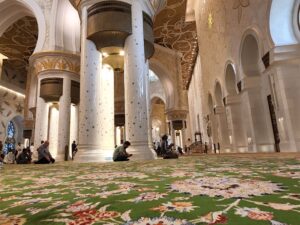How To Dress
- Description
- Curriculum
- Reviews

-
1Lesson 1.1: The Concept of Modesty
In this lesson, we’ll explore the Islamic concept of modesty, its significance, and how it influences daily life for Muslims. Modesty is a core value in Islam, extending beyond clothing to include behavior, speech, and interactions. This principle shapes a Muslim’s relationship with themselves, others, and Allah (God). Modesty in Islam fosters respect, humility, and sincerity, encouraging Muslims to live a life that honors their faith and community.
This lesson is designed to provide you with a foundational understanding of what modesty means in Islam and why it is valued. Through this exploration, you’ll gain insights into how modesty can positively impact personal growth, social interactions, and spiritual well-being.
-
2Lesson 1.2: Key Terms and Concepts
Learning Objectives
By the end of this lesson, learners will:
- Understand the concept of awrah and its role in the Islamic dress code for men and women.
- Explore the meaning, significance, and variations of the hijab.
- Recognize the broader aspects of modesty beyond clothing, including behavior and attitude.
-
3Lesson 2.1: Requirements for Men’s Clothing
Learning Objectives
By the end of this lesson, learners will:
- Understand the Islamic requirements for men’s clothing, including covering the awrah.
- Learn why silk and gold are prohibited for men in Islam.
- Recognize the importance of maintaining neatness and cleanliness in appearance as an act of faith.
-
4Lesson 2.2: Practical Applications
Learning Objectives
By the end of this lesson, learners will:
- Identify examples of appropriate clothing for daily wear, work, and prayer in alignment with Islamic principles.
- Understand the concept of moderation in clothing and the importance of avoiding extravagance.
-
5Lesson 2.3: Cultural Variations in Men’s Attire
Learning Objectives
By the end of this lesson, learners will:
- Understand traditional Islamic clothing styles across various cultures and their significance.
- Learn strategies for navigating cultural dress in non-Muslim societies while adhering to Islamic principles.
-
6Lesson 3.1: Guidelines for Women’s Clothing
Learning Objectives
By the end of this lesson, learners will:
- Understand the concept of awrah for women and its significance in Islamic teachings.
- Identify the characteristics of Islamic attire for women, including its emphasis on modesty, dignity, and functionality.
-
7Lesson 3.2: Understanding the Hijab
Learning Objectives
By the end of this lesson, learners will:
- Understand the importance of the hijab in Islamic teachings and its role in expressing faith and modesty.
- Explore the cultural variations of the hijab, including styles like the khimar, abaya, and jilbab, and their significance.
-
8Lesson 3.3: Practical Advice for Women
Learning Objectives
By the end of this lesson, learners will:
- Learn how to choose modest clothing suitable for various settings, including work, social gatherings, and prayer.
- Understand how to navigate challenges in adhering to Islamic dress in modern society while maintaining confidence and faith.
-
9Lesson 4.1: Modest Behavior and Attitude
Learning Objectives
By the end of this lesson, learners will:
- Understand the importance of aligning inner modesty (intentions and attitudes) with outer modesty (actions and appearance).
- Learn how to practice modesty in behavior by respecting others’ privacy and dignity.
-
10Lesson 4.2: The Spiritual Connection
Learning Objectives
By the end of this lesson, learners will:
- Understand how modest clothing serves as a reflection of one’s faith and spiritual values.
- Recognize the role of modesty in strengthening taqwa (God-consciousness) and deepening one’s connection to Allah.
-
11Lesson 5.1: Addressing Common Misunderstandings
Learning Objectives
By the end of this lesson, learners will:
- Be able to identify and clear common myths about Islamic dress codes.
- Understand and debunk stereotypes surrounding the hijab and Muslim attire, fostering a more accurate perception of Islamic modesty.
-
12Lesson 5.2: Overcoming Practical Challenges
Learning Objectives
By the end of this lesson, learners will:
- Learn strategies to navigate societal pressures and workplace expectations while adhering to Islamic principles of modesty.
- Understand how to adapt modest dress to different climates and environments without compromising faith.
-
13Lesson 6.1: Islamic Dress Across the World
Learning Objectives
By the end of this lesson, learners will:
- Understand how Islamic principles of modesty are reflected in diverse cultural attires.
- Appreciate the rich diversity within Islamic dress while recognizing the unifying guidelines that underpin it.
-
14Lesson 6.2: Balancing Faith and Culture
Learning Objectives
By the end of this lesson, learners will:
- Understand how to respect Islamic teachings while honoring their own and others’ cultural heritage.
- Learn how to avoid cultural appropriation and misrepresentation in the context of Islamic attire.
-
15Lesson 7.1: Quizzes and Case Studies
Learning Objectives
By the end of this lesson, learners will:
- Apply Islamic dress guidelines in real-world scenarios through interactive case studies.
- Evaluate their understanding of Islamic modesty and dress principles using self-assessment tools.
-
16Lesson 7.2: Community Discussions
Learning Objectives
By the end of this lesson, learners will:
- Share experiences and address real-life challenges in modesty through group forums.
- Engage in role-playing activities to gain practical understanding of Islamic dress principles in various situations.
-
17Lesson 8.1: Review of Key Principles
Learning Objectives
By the end of this lesson, learners will:
- Recall the key Quranic and Hadith teachings on dress and modesty.
- Summarize the practical lessons learned throughout the course for real-life application.
-
18Lesson 8.2: Personal Action Plan
Learning Objectives
By the end of this lesson, learners will:
- Develop a personalized plan for building a modest wardrobe aligned with Islamic teachings.
- Set both spiritual and practical goals to embody modesty in daily life, integrating outward and inward practices.







